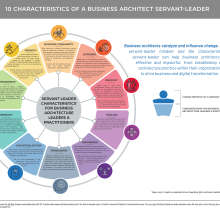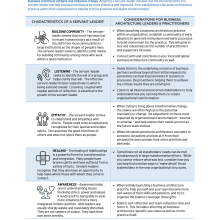Well, this is the last StraightTalk of the year (sniff) and with the holiday season upon us, it’s a good time to reflect and expand our perspective. We all know that being a successful business architect or having a successful business architecture practice is not only about what we do, but also about how we do it. (Check out Ways of Working here in Post No. 64, The Business Architect Imperative.) Let’s take that how to a whole new level here as we look at the concept of servant leadership.
We are joined by an entirely unique expert in this area, Jeff Dols, who is not only an experienced business architect but also has a Master’s degree in Servant Leadership and has held leadership roles such as serving as Executive Director of the Franciscan Spirituality Center.
Business architects catalyze and influence change. Change comes from both establishing a business architecture practice within an organization as well as through the daily work of leveraging business architecture to inform and reshape decision-making, strategy translation, transformation, simplification and other usage scenarios. Considering the work we do, and the importance of influence, adopting a servant-leader mindset and the characteristics of a servant-leader can help business architects to be more effective and impactful.
We interviewed Jeff on this topic and he breaks down for us what servant leadership is, why it is so important, and how servant-leader characteristics can help business architects to become more successful. This post is based on our interview with him.
Disclaimer: we’ve made some adjustments for our typical StraightTalk-style: the gray headings represent StraightTalk asking the questions and our guest, Jeff, responds in turn.
Make sure to check out Jeff’s interview firsthand to hear the whole story, with examples, in our StraightTalk podcast 10-Minutes With Jeff Dols: The Concept of Servant Leadership and Business Architecture.
Here goes.
What is servant leadership?
Jeff: The servant leadership movement that we know really started with Robert Greenleaf, who was a long-time AT&T executive. His observations of effective leadership and his reading of Hermann Hesse’s Journey to the East, in which the central figure, Leo – who accompanies the traveling party as the servant and does menial chores – is also a person of extraordinary presence. Later in the story, it is discovered that Leo was, in fact, a great noble leader of the order. So, from this story and Greenleaf’s experiences at AT&T, I see him drawing three primary conclusions about what servant leadership is.
- First, it is calling on established leaders to choose to lead through service, rather than relying only on command and control.
- Secondly, it is helping those who already serve to develop their leadership abilities and calling forth their inner leader.
- And finally, it is calling forth those who are being served to now serve others. This leads to Greenleaf’s best test for servant leadership: “Do those served grow as persons? Do they, while being served, become healthier, wiser, freer, more autonomous, more likely themselves to become servants?”
How did you come to the idea of servant leadership and why is this concept so important?
Jeff: It was actually somewhat by accident – or destiny – if you prefer. In 2006, in the midst of launching a business architecture practice at a big financial services firm, I was starting to think about going back to graduate school, but the idea of getting an MBA wasn’t calling out to me. Out of the blue, a friend mentioned that Viterbo University in La Crosse, Wisconsin USA was starting a local cohort in my community of its servant leadership program and asked if I’d be interested. At that point, I had no idea what servant leadership was, but I instinctively said yes. And it turned out to be a life-changing decision.
What trends do you see around servant leadership?
Jeff: I’m hearing more about corporations adopting servant leadership as part of their corporate culture. Here are just a few examples. Southwest Airlines has long been known for its servant leadership culture. Kwik Trip has tightly integrated servant leadership into their corporate training programs. And more recently, United Health Group’s commitment to servant leadership as part of their corporate cultures and values is one of the reasons I chose to work for Optum.
Another trend is that the Agile community is embracing servant leadership, which fits well with the Agile principle of self-organizing teams. For instance, at Optum, servant leadership is one of the required courses in the Agile training curriculum.
How can a servant leadership mindset and approach help business architects to be more effective and impactful in their roles?
Jeff: One of the other visionaries in the servant leadership movement, Larry Spears, took Greenleaf’s initial work and developed a set of ten Characteristics of the Servant-Leader. While others have come up with their own lists of servant-leader qualities, I’ve found these to be quite helpful and adaptable in my career as a business architect.
As a whole, the ten characteristics tend to support each other in helping the leader to balance their inner development and its outer expression in their relationships to others and the world. Taken individually, I have found each characteristic can be applied in different contexts in the life of a business architect. This includes working with stakeholders on mapping business architecture to launching, leading and growing a business architecture practice.
Can you give us an example?
Jeff: For me, there are three characteristics that have been particularly impactful from a business architecture perspective: Building Community, Commitment to the Growth of People and Leading Through Persuasion.
- Building Community – When launching a business architecture practice within an organization, I found it essential to establish a community of early adopters to generate enthusiasm and early successes to build momentum for the practice. The small community eventually grew in size and robustness as the number of practitioners and supporters increased.
- Commitment to the Growth of People – As you are establishing your business architecture practice, the key is to find a way to replicate yourself. This means actively growing the next generation of business architects. We need to avoid the temptation to do everything ourselves, even if that sometimes seems like an easier path in the short run. I found that trying to be a hero only leads to burn out of senior architects and a lack of growth opportunities for those who follow in their footsteps.
- Leading through Persuasion – Business architects often work in a matrixed environment, and rarely have line authority over their key partners and stakeholders. In fact, we often work with teams that include leaders more senior than we are. To thrive, we need to be confident and able to influence others through the strength of our ideas, commitment, and passion – rather than through command and control.
For me, this has become my preferred way of leading, even when I do have line authority over a team. The commitment of the team is so much stronger when they are following because they truly believe, and not just because they are compelled to.
Check out the quick reference diagram and comprehensive table from Jeff that describes all ten characteristics of the Servant-Leader along with considerations for each, specifically related to business architecture leaders and practitioners.
The concept of servant leadership is new to many of us, so where do we start?
Jeff: Start with Robert Greenleaf’s original essay, The Servant as Leader. It’s a quick read and gives you a good overview of where he was headed with the servant leadership concept.
From there, check out some of the other resources in the reading list below. (See More Good Stuff.) I would especially recommend the TED Talk from my mentor Tom Thibodeau. He’s truly an amazing, dynamic and authentic speaker. I owe so much to Tom for my servant-leader’s journey.
Anything else?
Jeff: The servant leadership journey has been life-changing for me, and not just for my work as a business architect, but also in my relationships with family and friends and my volunteer work. In fact, it was through servant leadership that I first discovered the movement toward public Benefit Corporations, which fueled my interest in applying business architecture to non-profits and startups, and ultimately led me to Whynde and her inspiring work with Architecting for Good (A4G).
BTW, you can learn more here about Architecting For Good (A4G) and share your passion to make a difference by helping others.
More Good Stuff…
10-Minutes With Jeff Dols: The Concept of Servant Leadership and Business Architecture (StraightTalk podcast): Just in case you missed that link right there in the beginning, make sure to check out Jeff’s podcast, which was the basis for this post, where he speaks with us about how servant leadership can help business architects become more effective and impactful.
If you’d like to dig into the topic of servant leadership further, here’s a recommended reading list from Jeff (in suggested order).
- Greenleaf, Robert K. Servant-leadership: A Journey into the Nature of Legitimate Power & Greatness. Mahwah, NJ: Paulist Press, 1977.
- Spears, Larry C. Insights on Leadership: Service, Stewardship, Spirit, and Servant-Leadership. New York, NY: John Wiley & Sons, 1998.
- Fris, Dr. Joe. “An Additional Way of Thinking About Organizational Life and Leadership: The Quantum Perspective.” Canadian Journal of Educational Administration and Policy. CJEAP, Issue #48, January 5, 2006.
- De Pree, Max. Leadership is an Art. New York, NY: Currency Doubleday, 2004.
- Mitroff, Ian I. and Elizabeth A. Denton. A Spiritual Audit of Corporate America: A Hard Look at Spirituality, Religion, and Values in the Workplace. San Francisco, CA: Josey-Bass, Inc., 1999.
- Honeyman, Ryan. The B Corp Handbook: How to Use Business as a Force for Good. Oakland, CA: Berrett-Koehler Publishers, Inc., 2014.
- Block, Peter. Stewardship: Choosing Service Over Self-Interest. San Francisco, CA: Berrett-Koehler Publishers, 1993.
- Cashman, Kevin. Leadership from the Inside Out: Becoming a Leader for Life. Minneapolis, MN: TCLG, LLC, 1998.
- Wren, Thomas J. The Leader’s Companion. New York, NY: The Free Press, 1995.
Robert K. Greenleaf Center for Servant Leadership: A fantastic website with many options to learn more about servant leadership.
The Future of Management Is Teal (Strategy+Business): An outstanding article on how organizations are moving forward along an evolutionary spectrum, toward self-management, wholeness, and a deeper sense of purpose. Also check out the book on Reinventing Organizations: A Guide to Creating Organizations Inspired by the Next Stage of Human Consciousness.
Positive Power of Servant Leadership (TED Talk): A compelling TED Talk by Tom Thibodeau, distinguished professor of servant leadership at Viterbo University, on how all of us can practice servant leadership because we all serve. The positive power of servant leadership is expressed every day through our words, our presence and our commitment to the common good. Yes!


